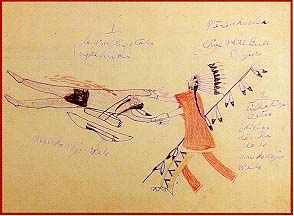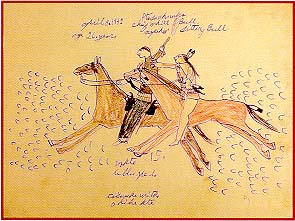the artists employed, it is possible to grasp the essentials of the
story the narrator is trying to tell. For example, in a pictograph the action
moves from right to left. The features of the principal actor may be so
undefined as to be unrecognizable; however, his fellow warriors could easily
identify him. White Bull usually portrayed himself with his trademark war
charm by his side, a pouch trailing a buffalo tail and an eagle feather.
Other conventions White Bull and his fellow warrior-artists employed
provided additional essential information. Puffs of smoke signalled bursts
of gunfire, dashes established the trajectory of bullets, and the location
of wounds was indicated by spurting blood.
Walter Stanley Campbell used many of these drawings when writing Warpath:
The True Story of the Fighting Sioux Told in a Biography of Chief White
Bull, to provide colorfully written descriptions of what White Bull
and his contemporaries wore and carried into battle. In the early 1930s,
Vestal paid White Bull for copying many of the pictographs that the artist
had drawn a half-century earlier. He also compensated him for the interviews
granted and was careful to observe the protocol considered appropriate

In this scene, White Bull rescues his friend Hairy Hand
who was shot by soldiers defending their position at the Wagon Box Fight
in Wyoming, August, 1867. |

White Bull drags a soldier from his horse at the Battle
of the Little Big Horn River in Montana, June, 1876. White Bull stated,
"I struck this one and pulled him off his horse, Crazy Horse hit him
second."
in such circumstances. Campbell supplied the artist with paper, crayons,
and colored pencils. This accounts for the standard size of the drawings
and the limited number of colors used. With one exception, the drawings
are on a textured paper 8.75 inches (22.2 cm) high by 11.75 inches (29.9
cm) wide. All employ pencil, colored pencil, and crayon to depict the events
in White Bull's life. Vestal had great confidence in the veracity of White
Bull's accounts and prided himself on having sought out and preserved the
participant accounts of a rapidly dying breed, the plains warrior.
A student of the classics and a romantic, Vestal compared Kit Carson,
the Mountain Man, who was the subject of one of his biographies, to Odysseus
the wandering king of Greek myth. He thought of White Bull in terms of other
Greek heroes. "To me, at least," Vestal declared, "it is
no small matter to have known and talked with a man straight out of Homer."
It was fitting that when he considered where his own final resting place
would be that Stanley Vestal chose to be buried among the fighters he so
admired - both Indian and white. Today he lies in the federal cemetery along
the Little Big Horn where he believed that White Bull had killed Custer. |

